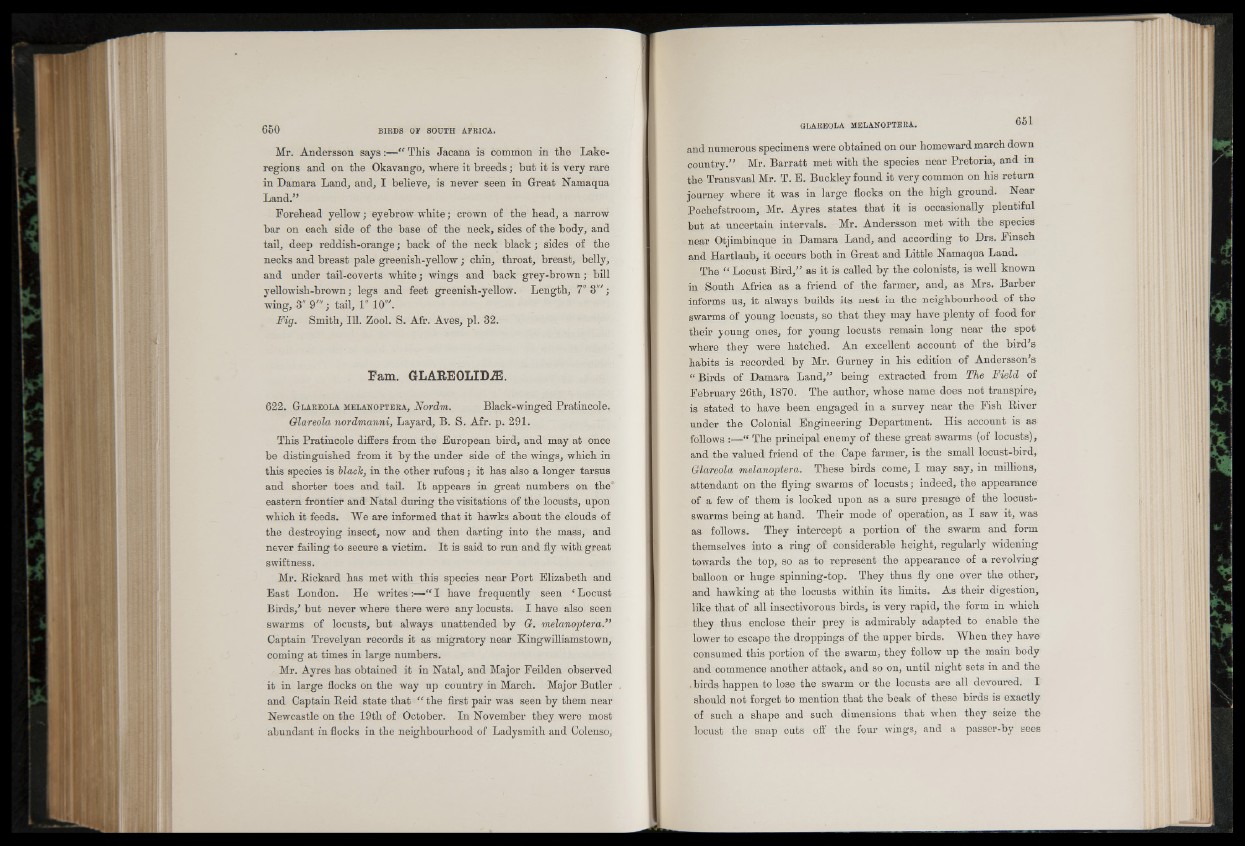
Mr. Andersson says:—“ This Jacana is common in the Lake-
regions and on the Okavango, where it breeds; but it is very rare
in Damara Land, and, I believe, is never seen in Great Namaqua
Land.”
Forehead yellow; eyebrow white; crown of the head, a narrow
bar on each side of the base of the neck, sides of the body, and
tail, deep reddish-orange; back of the neck black; sides of the
necks and breast pale greenish-yellow; chin, throat, breast, belly,
and under tail-coverts white; wings and back grey-brown; bill
yellowish-brown; legs and feet greenish-yellow. Length, 7" 3'";
wing, 3" 9"'; tail, 1" 10'".
Fig. Smith, 111. Zool. S. Afr. Aves, pi. 32.
Fam. GLARE OLIDiE.
6 2 2 . G lareola melanopteba, Nordm. Black-winged Pratincole.
Glareola nordmanni, Layard, B. S. Afr. p. 291.
This Pratincole differs from the European bird, and may at once
be distinguished from it by the under side of the wings, which in
this species is black, in the other rufous; it has also a longer tarsus
and shorter toes and tail. It appears in great numbers on thes
eastern frontier and Natal during the visitations of the locusts, upon
which it feeds. We are informed that it hawks about the clouds of
the destroying insect, now and then darting into the mass, and
never failing to secure a victim. It is said to run and fly with great
swiftness.
Mr. Rickard has met with this species near Port Elizabeth and
East London. He writes :—“ I have frequently seen f Locust
Birds/ but never where there were any locusts. I have also seen
swarms of locusts, but always unattended by G. melanoptera.”
Captain Trevelyan records it as migratory near Kingwilliamstown,
coming at times in large numbers.
Mr. Ayres has obtained it in Natal, and Major Feilden observed
it in large flocks on the way up country in March. Major Butler
and Captain Reid state that “ the first pair was seen by them near
Newcastle on the 19th of October. In November they were most
abundant in flocks in the neighbourhood of Ladysmith and Colenso,
and numerous specimens were obtained on our homeward march down
country.” Mr. Barratt met with the species near Pretoria, and in
the Transvaal Mr. T. E. Buckley found it very common on his return
journey where it was in large flocks on the high ground. Near
Pochefstroom, Mr. Ayres states that it is occasionally plentiful
but at uncertain intervals. Mr. Andersson met with the species
near Otjimbinque in Damara Land, and according to Drs. Finsch
and Hartlaub, it occurs both in Great and Little Namaqua Land.
The “ Locust Bird,” as it is called by the colonists, is well known
in South Africa as a friend of the farmer, and, as Mrs. Barber
informs us, it always builds its nest in the neighbourhood of the
swarms of young locusts, so that they may have plenty of food for
their young ones, for young locusts remain long near the spot
where they were hatched. An excellent account of the bird s
habits is recorded by Mr. Gurney in his edition of Andersson s
“ Birds of Damara Land,” being extracted from The Field of
February 26th, 1870. The author, whose name does not transpire,
is stated to have been engaged in a survey near the Fish River
under the Colonial Engineering Department. His account is as
follows :—“ The principal enemy of these great swarms (of locusts),
and the valued friend of the Cape farmer, is the small locust-bird,
Glareola melanoptera. These birds come, I may say, in millions,
attendant on the flying swarms of locusts; indeed, the appearance
of a few of them is looked upon as a sure presage of the locust-
swarms being at hand. Their mode of operation, as I saw it, was
as follows. They intercept a portion of the swarm and form
themselves into a ring of considerable height, regularly widening
towards the top, so as to represent the appearance of a revolving
balloon or huge spinning-top. They thus fly one over the other,
and hawking at the locusts within its limits. As their digestion,
like that of all insectivorous birds, is very rapid, the form in which
they thus enclose their prey is admirably adapted to enable the
lower to escape the droppings of the upper birds. When they have
consumed this portion of the swarm, they follow up the main body
and commence another attack, and so on, until night sets in and the
. birds happen to lose the swarm or the locusts are all devoured. I
should not forget to mention that the beak of these birds is exactly
of such a shape and such dimensions that when they seize the
locust the snap cuts off the four wings, and a passer-by sees